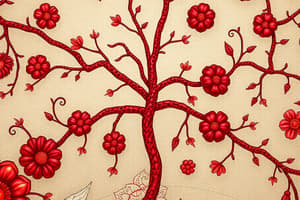Podcast
Questions and Answers
What is the primary function of the circulatory system that involves the movement of oxygen and nutrients?
What is the primary function of the circulatory system that involves the movement of oxygen and nutrients?
- Transport (correct)
- Protection
- Inflammation
- Regulation
Which component of blood is responsible for initiating the clotting process?
Which component of blood is responsible for initiating the clotting process?
- Plasma
- White blood cells
- Red blood cells
- Platelets (correct)
What percentage of whole blood is made up of plasma?
What percentage of whole blood is made up of plasma?
- 55% (correct)
- 40%
- 85%
- 70%
What is the primary purpose of leukocytes in the blood?
What is the primary purpose of leukocytes in the blood?
Which of the following is NOT a function of the circulatory system?
Which of the following is NOT a function of the circulatory system?
How many liters of blood does an adult typically have?
How many liters of blood does an adult typically have?
What are the formed elements of blood primarily composed of?
What are the formed elements of blood primarily composed of?
What is the main characteristic of plasma?
What is the main characteristic of plasma?
Flashcards are hidden until you start studying
Study Notes
Introduction to Blood
- The circulatory system comprises the heart, blood vessels, and blood.
- Hematology is the branch of medicine focused on the study of blood.
- Primary functions of the circulatory system include:
- Transport: Delivers oxygen (O2), carbon dioxide (CO2), nutrients, waste products, hormones, and stem cells throughout the body.
- Protection: Involves immune responses including inflammation, limiting infection spread, destroying pathogens and cancer cells, neutralizing toxins, and initiating clotting mechanisms.
- Regulation: Maintains fluid balance, stabilizes blood pH, and assists in temperature control.
Components and General Properties of Blood
- An adult typically contains 4-6 liters of blood.
- Blood is classified as a liquid connective tissue.
- Plasma: The matrix of blood, characterized as a clear, light yellow fluid.
- Formed elements: Comprised of blood cells and cell fragments, includes red blood cells (erythrocytes), white blood cells (leukocytes), and platelets (thrombocytes).
Formed Elements of Blood
- Types of blood cells:
- Erythrocytes: Carry oxygen via hemoglobin.
- Leukocytes: Divided into several types including:
- Neutrophils: Most abundant white blood cells, crucial in fighting infections.
- Lymphocytes: Key players in immune response (includes small lymphocytes and large lymphocytes).
- Monocytes: Largest type of white blood cell, essential in pathogen defense and tissue repair.
- Eosinophils: Combat multicellular parasites and allergic responses.
- Basophils: Involved in inflammatory reactions, releasing histamine.
Separating Plasma From Formed Elements of Blood
- Blood can be separated into its components through centrifugation.
- Plasma: Comprises 55% of whole blood and contains water, electrolytes, nutrients, hormones, and waste products.
- Buffy coat: A thin layer that contains leukocytes and platelets, situated between plasma and red blood cells.
Studying That Suits You
Use AI to generate personalized quizzes and flashcards to suit your learning preferences.



